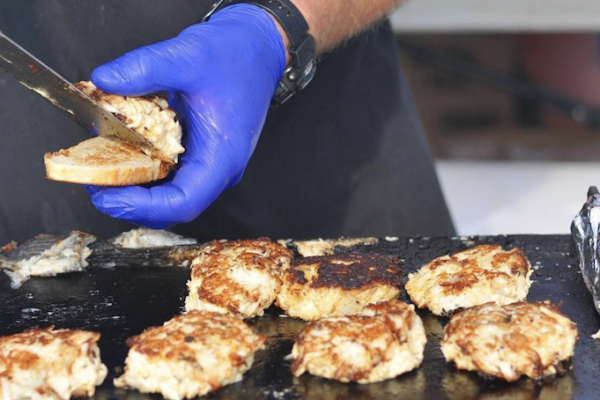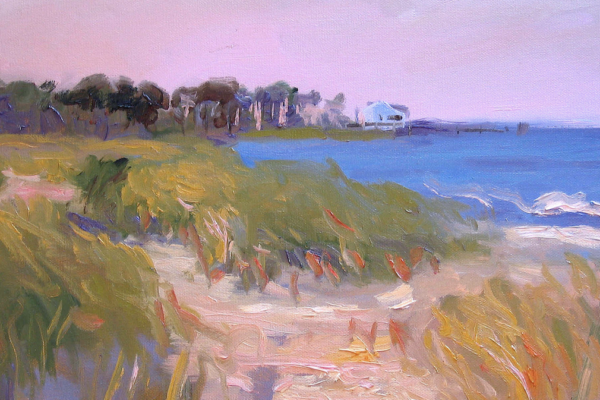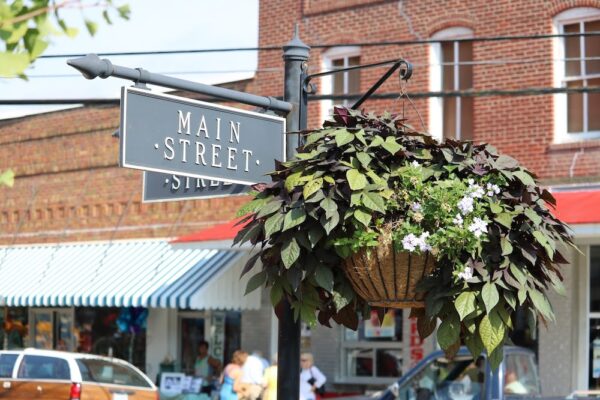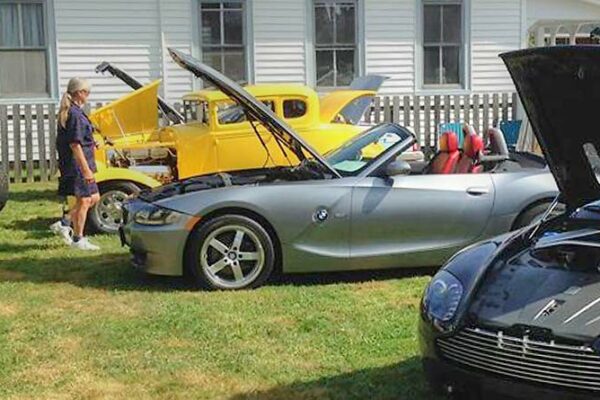Spring is one of our favorite seasons, because it looks so darn good on Mathews County. Main Street flower baskets and seasonal landscaping start appearing, the luscious woods fill out again, shrubbery and sea grasses revive on the beaches, local farms are bursting with new life, and residents carefully start manicuring their lawns again. Spring is in full swing, and many residents have made a few exceptions to staying indoors during the coronavirus pandemic through exercise, trash cleanup, and gardening! Staying isolated doesn’t mean that you can’t enjoy the bit of yard, deck, or outdoor space that you live with. Though many non-essential retails businesses have been closed, hardware stores and gardening centers have been consistently steady as people have more time on their hands to finally get to those home improvement projects they’ve been too busy to do over the years, or too lazy, but who’s keeping track? P.S How many other home improvement projects have you finally got the time to complete? I’m gonna guess you’ve finally installed an alarm system at the home you moved into years ago and at long last added a lick of paint to your firstborn’s bedroom!
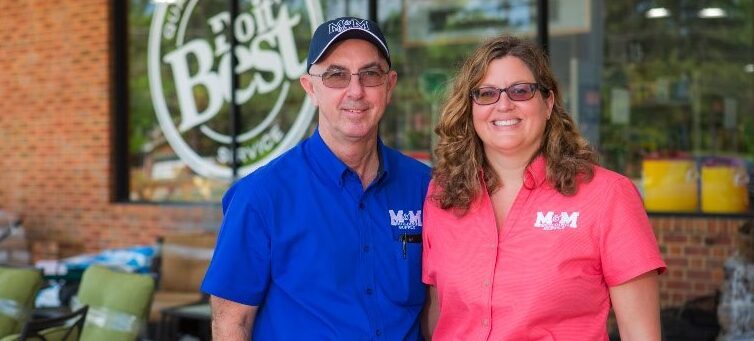
Gardening is good for the soul
Many locals have resorted to gardening, to battle the blues of being stuck at home. In honor of Earth Day, this is great news! Outside of the personal victories one feels from nourishing a tangible thing into something bigger and productive, gardening has TONS of health benefits. Because of this, we’re sharing an interview with a community member that is our very own local expert, Kathryn Tatterson. Kathryn is Vice President of M&M Building Supply and the mastermind behind their highly active garden center, and she’s known what others are now discovering all along. Oh, and by the way, she is one of the responsible bodies behind those gorgeous Main Street flower baskets, so you might want to listen up!
Gardening has so many benefits! Gardening is great exercise and is good for the spirit, so there is the whole mind/body thing! Microbes in soil have recently been found to fight depression. [It’s true, look it up!] The work of gardening produces clearly visible, tangible and often immediate results. And with gardening there is always something to look forward to — new flowers that have started to bloom. There is so much truth in the saying: ‘To plant a garden is to believe in tomorrow.’ Today, in the uncertainty that we are facing during the coronavirus pandemic, this has never been more true. However, it also takes commitment and work. There are many things that can go wrong in a garden and so you need to make sure you take all the precautions to make sure your garden flourishes. For instance, you share your garden with others creatures – mammals birds, and insects. In some cases, they might get a bit too comfortable with your plants, so insecticides and chicken wire are good ways to stop hungry mouths from feeding on your flowers and produce. In rare cases, people need to call in a pest control treatment company to get rid of an infestation but it should never get this bad. Especially when you are taking the best gardening advice and putting time and effort in looking after your garden. Never mind these hurdles, it is all worth it. Plus, who doesn’t like a challenge!
Enjoy getting to know your local garden expert, and see what she has to say about some of our [novice] interview questions on gardening. Also, don’t forget to shop local when you are planning out your next plant run!
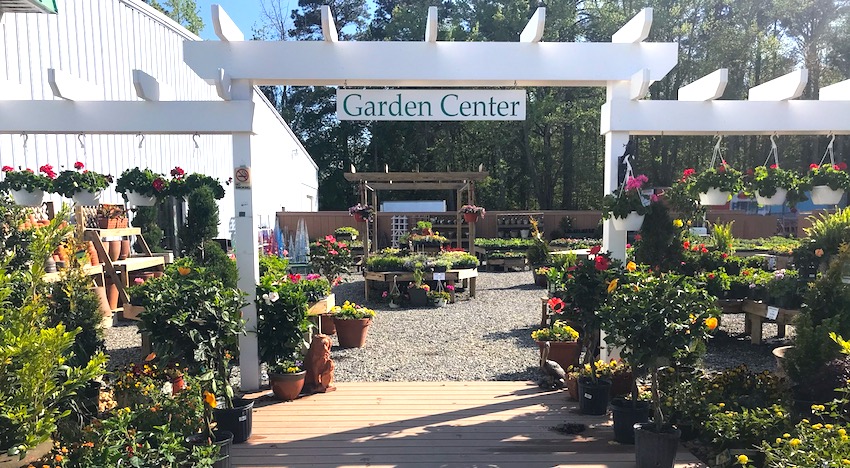
An Interview with Kathryn Tatterson of M&M Building Supply’s Garden Center
1. First comes first, there is a lot of misconception that April 15th is the traditional ‘last frost date’, can you elaborate on this?
The date of the last frost in Mathews is between April 21-April 30. My assumption on the April 15 date is that this is the same as when we watch the weather forecast on television– the information is most accurate for Norfolk, VA area and it is typically several degrees cooler here. April 15-April 21 are the average dates for last frost in Norfolk. Our location being north of our nearest metro area makes a difference in the weather conditions here.
Kathryn recommends May 1 as a safe date to begin planting your garden.

Photo by Morgan Hudgins 
Photo by Morgan Hudgins
2. Now let’s peel things back to the basics, for those Mathews ‘Gardening 101’ types out there. What are the benefits of planting seasonal versus perennial outdoor plants? Do you have examples of popular shrubs/bushes that make good perennial purchases?
To over-simplify: Plants fall into two giant categories– herbaceous and woody.
Woody plants are woody– they have thick stems that are present in winter. Trees and shrubs or bushes are woody plants. Woody plants are then divided into trees and shrubs by their size/growth habit and deciduous (lose their leaves) or evergreen (leaves remain in winter).
Herbaceous plants do not have woody stems. This group is divided into annuals and perennials (and also biennials but we will ignore these for now).
Annuals are plants that complete their life cycle in one year. Perennials are plants that die back to the ground but reemerge year after year. A number of annuals seem to come back each year, but what they are actually doing is producing seed that germinates successfully again and again, year after year. Many people find this happening with annual vinca (Catharanthus rosea). To make things more confusing, there are a number of plants that are perennial somewhere but not here in our zone. We are in Zone 7 close to the border with Zone 8. These plants are known as “tender perennials” or if they are hardy in Zone 10 – “tropicals”
Generally, perennials are planted once for years to come but have a much shorter flowering window– often 4-6 weeks where annuals provide color for 4-6 months.
ALL are good purchases in my opinion! And I truly feel like you should plant what you love (while being aware of how many hours of direct sunlight areas in your garden receive, so you can accurately choose the RIGHT PLANT for the RIGHT PLACE.
3. Have you noticed more residents trying out gardening, or buying more plants during the coronavirus? Do you have any online resources that they could look at for planting correctly or “how to get started” guides?
One million percent yes! We are selling unprecedented numbers of seed packs this year! And vegetable and herb plants as well. Vegetable gardening also helps with our nation’s food security. We cannot grow toilet paper– but you can grow tomatoes! As most people under a stay at home order are spending far more time at home than usual, they are filling that time with home improvement and gardening projects.
Monrovia, one of our vendors, has a fantastic website with so much information on every plant they grow. Proven Winners has another great site and we carry a majority of their annual line.
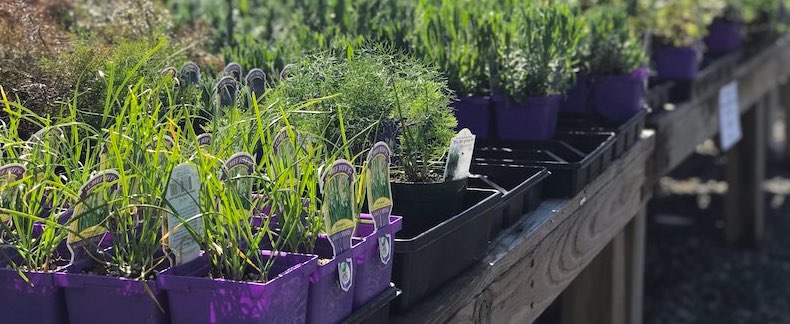
4. Do you have any essential safety tips that new gardeners should know about before starting?
Safety comes first in the garden! Whilst most of the time it is one of the safest things to do in the world, there are obviously some dangers. Garden tools can be sharp and even the most experienced gardener with cut themselves badly from time to time. Keep tools locked up so that inexperienced people (and thieves!) don’t have access to them. The same goes for items such as lawnmower fuel and fertiliser. If you use fuel and fertilser in your garden, click here to get yourself a chemical storage cabinet ASAP. Spilled chemicals are not only a health and fire hazard to you and your family, but they are also a bio-hazard to wildlife and the environment. If you can, switch to an electric lawnmower and go without fertiliser and other chemicals like weedkiller and pesticide. If you absolutely have to use them, opt for organic and bee-friendly instead, but still keep it all locked up.
5. Do you have any tips for ensuring a healthy vegetable garden? Perhaps techniques on placement, soil, plant food?
For best results most vegetable gardens should be in full sun. Certain vegetables such as lettuce- can do well in partial sun and would need afternoon shade to do well in summer.
Different plants are adapted to different environments. Vegetable plants such as broccoli, cabbage, collards and kale (cole crops) do well when planted in early spring or late summer for fall. They can survive frosts and with some protection possibly over winter. Tomatoes, eggplant and peppers prefer warmer weather and are not happy being outside in temperatures under 50 degrees.
Each week in the spring we receive fresh new shipments of vegetable and herb plants from a Virginia greenhouse. These plants come to us direct from a warm greenhouse and the cool weather outdoors can be a shock to them. We unload our plants on racks and keep them under cover to “harden off” or acclimate to the cooler outdoor temperature for a bit of time which is determined by the weather. Hardening off plants can be accomplished bringing plants in to a covered but unheated area so the plant has time to adjust to the change in its environment.
How often should you water vegetable gardens?
As for watering, newly planted plants need more frequent watering until their roots grown in and establish. Once roots are established, as a general rule, plants need one inch of water per week. This is often taken care of by rain, but in times of drought of extreme heat or wind you may need to drag a water hose.
Also, planting flowers in or around your vegetable garden has benefits as well as being attractive. Marigolds deter nematodes as well as the benefit of flowers attracting more pollinators to the garden. And more pollinators =higher yield for your vegetable plants.
6. [Pretext to the next question: if you are anything like me, you don’t have the best relationship with indoor plants even if you LOVE them (to death). In fact, someone at the farmers market once recommended a plant for me that she considered the “hard to kill ’em” types, I was delightfully offended she could know me so well. So, I bought three. This one goes out to those overzealous watering types, like me! ]
What are the biggest mistakes you see with indoor plant ownership?
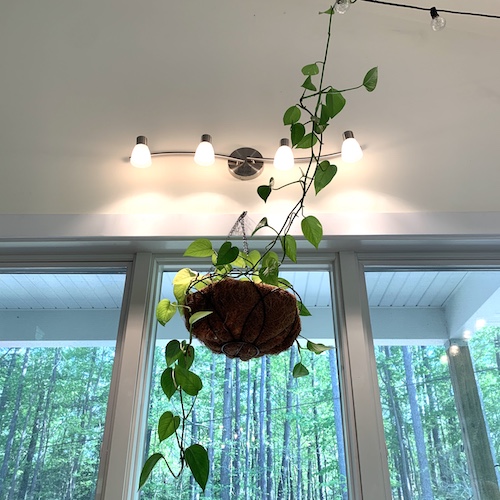
The biggest mistake with indoor plant ownership is watering — overwatering and underwatering. In an indoor environment (without wind and full sun that dries plants out) most often over watering and root disease is a problem. [Say it louder, for the people in the back!] Make sure that after watering your indoor plants you don’t let the plant remain sitting in a wet saucer. Dump the saucer! Then check again in a few minutes or an hour– if there is standing water dump the saucer again!!
7. Many areas in Mathews have different soil conditions, do you have suggestions for property owners about how to assess their soil, and what might help?
For many different soil conditions– sandy soil, clay soil, poor soil– the solution is the same, adding organic matter such as compost or manure.
We sell soil test kits in our lawn and garden section. You can reach out to the local extension agent if you feel you need more intensive soil tests done.
8. Lastly but most importantly, what is your favorite combination of flowers, vines, etc for large pots or porch displays?
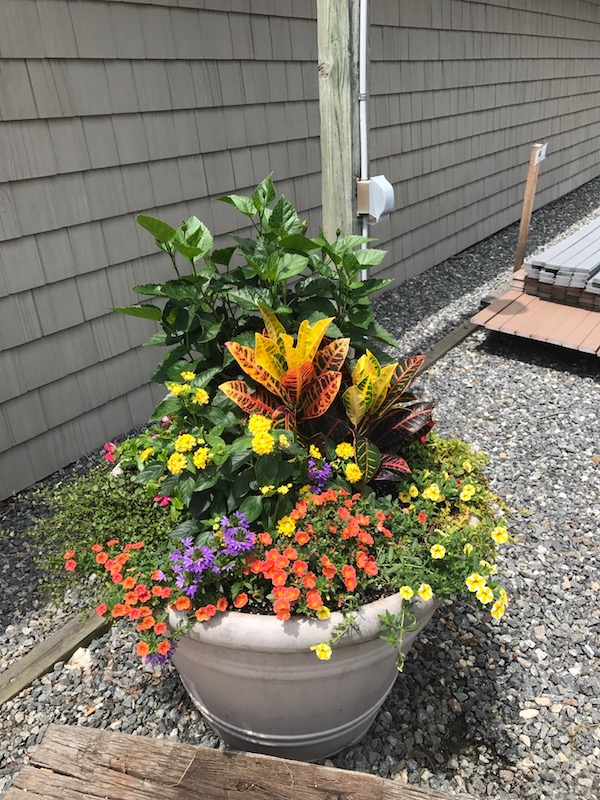
Container with Croton 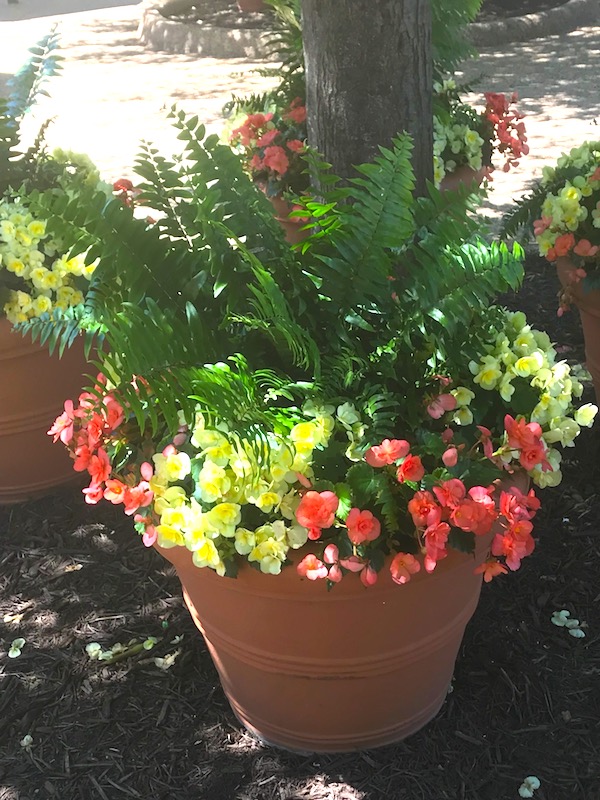
Solenia Begonia and Macho Fern
Now, this is one of my FAVORITE topics! I love love love to create mixed containers. Many people are familiar with the THRILLER, FILLER, SPILLER method of container gardening. The premise is for a gorgeous container garden you need a THRILLER, FILLER and SPILLER. If you aren’t familiar here’s the breakdown:
A THRILLER is an upright or vertical element in your container. Popular thrillers are Draceana ‘Spike’ (spike plant), Juncus (rush) and Pennisetum ‘Rubrum’ (purple fountain grass). Thrillers can also be upright flowering plants such as Angelonia (summer snapdragon).
A FILLER sounds boring but is actually the most important choice– the plant or plants you choose to fill your container. The choices are endless but I like to start with a color you love or flower that makes you happy and go from there.
Lastly, SPILLERS are plants that cascade and spill down the edge. In a round pot I prefer three. Vinca vine or bacopa are traditional choices- but there are many options for trailing elements.
There are no hard and fast rules when it comes to container gardening. Mixing shrubs, tropicals, annuals even edibles is allowed and encouraged. Currently my favorite plants for mixed containers include Croton ‘Petra’, Solenia begonias, and any calibrachoa.

